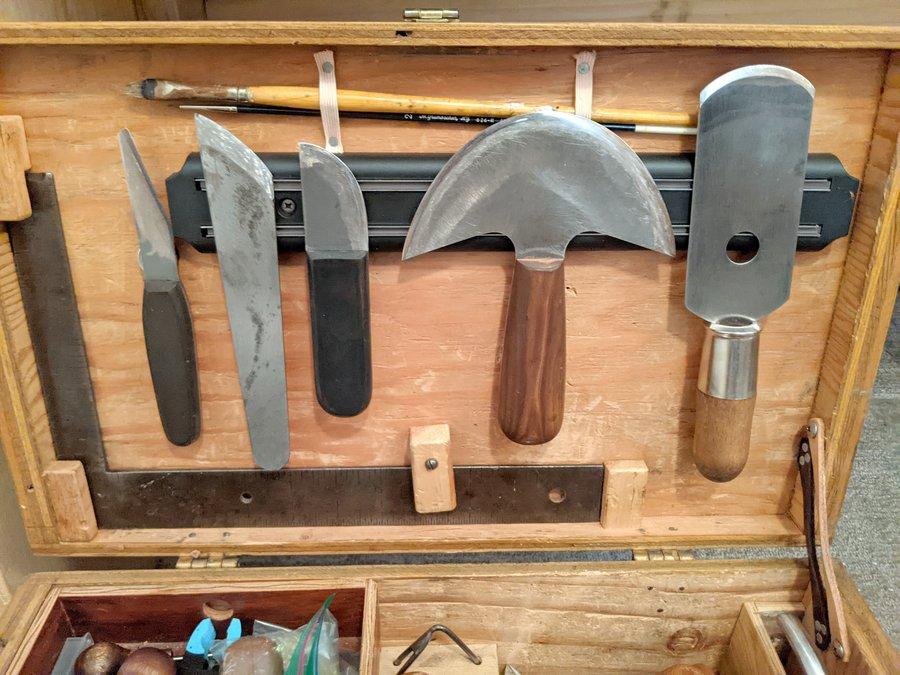-
Posts
503 -
Joined
-
Last visited
Content Type
Profiles
Forums
Events
Blogs
Gallery
Everything posted by MarshalWill
-
Nice work. don't worry too much about the color, or lack of it. Chuck is right. Nothing looks better than aged leather. I have wet molded it and set it in the sun to dry. It also speeds the natural darkening process, giving the leather a nice patina.
-
Very nice. That Landis sure does the trick.
-
You could get along without the chisels if you punch the holes with a stitch awl. I've been working leather for 50+ years and never had a set of chisels. You can make a good, even line of holes with a bit of practice. I learned to stitch in a saddle shop and we just learned to use a stitch awl. There are good books on saddle stitching that can get you going in the right direction. Then, if you wish, you can invest in some chisels but it will b e a choice, not a necessity. I used to have a stitching pony but it never held the work tight enough without marking the leather so I finally got rid of it and just work without it. FWIW, we never had a stitching pony in the saddle shop, either. You may be able to find one that does the job, though.
-
Beautiful. I had to look all over for a bag to carry my laptop with a 17" monitor. This is way more classy.
-
I like the design. It's the next step more coverage from a Yaqui Slide.
-
There's a twelve step program for holsters. Step 12 is your twelfth holster. Then you start over.
-
I hand stitch everything. That said, maybe the tension is set right but the leather thickness/density is slightly inconsistent.
-
Here's a holster I made out of belly leather to test a pattern. Notice the stitching along the lower curve did the same thing yours did. I would never use that quality leather for anything other than a test piece.
-
For a first one, you nailed it. The leather bunched up along the part where the stitching isn't perfect. The issue doesn't look so much like your skill at stitching as it does possibly indicate a soft part of the leather, like you would find closer to the belly of the hide. Belly leather seldom stitches nicely. I burnish all the edges to give a nice finished look. A soft part in the leather won't burnish well, either. I always make holsters from the better part of a hide for this reason. Keep making them, you are doing very good work.
-
-
Good inspiration. LOL, all putty knives should look so good. Good suggestion to experiment with pieces for heat treating. I've found that in a lot of cases old saw blades are made of better steel than new ones. Good inspiration. LOL, all putty knives should look so good. Good suggestion to experiment with pieces for heat treating. I've found that in a lot of cases old saw blades are made of better steel than new ones. Good inspiration. LOL, all putty knives should look so good. Good suggestion to experiment with pieces for heat treating. I've found that in a lot of cases old saw blades are made of better steel than new ones. Good inspiration. LOL, all putty knives should look so good. Good suggestion to experiment with pieces for heat treating. I've found that in a lot of cases old saw blades are made of better steel than new ones. Oops. Sorry about the multiple taps. But then, it does hammer the message home.
-
What color do you heat them to before quenching?
-
I'm a firm believer of the saw blade option. If you're careful to not heat the cutting edge when you shape it, some saw blades have enough temper to hold a good edge without heat treating.
-
-
Well, there you go. It now has an official purpose.
-
We'll just call it a lightening hole, then.
-
By all means. It works great. The saw blade center hole didn't do much for it, though, unless you want to hang it up on a hook.
-
I've made all these from saw blades. I use the one on the right for skiving more than the rest although the two on the left work good, too, depending on the type of skiving I need to do. You can find good Japanese made knives of similar designs on ebay or Amazon that hold an edge well.
-
Outstanding! That really brought out the details. Good work.
-
Dying the background would certainly do the trick. It wouldn't even have to be very contrasting, either.
-
Very well done. Looks realistic, which takes a good eye and touch with the tools. If you want to subdue the background stamping, could you go over it lightly with a modeling spoon?
-

Matching border stamps and basket or geometric stamps.
MarshalWill replied to bruce johnson's topic in Stamping
Good information. I generally follow Bruce's rule(s) depending on other variables, of course. rktaylor, my all favorite border stamp is the same Hackbarth one you show on the left. I have a few others but that one I use more than others. -

What kind of files are used to mod or make stamps?
MarshalWill replied to LakeOtter's topic in Stamping
I use Jeweler's files along with what ever else will give the desired result. Here's a thread on how I made one stamp. -
Your laser-made stamp looks to be good. Yes, if you want the impression to stand out more antiquing would certainly do the trick. For comparison, here's a stamp I had professionally made and the impression it makes. This one is 1-1/4" long. You may be onto a good sideline, as well.
-
You do have a good product idea there. I particularly like the 'hotel' designs. Especially the HOTEL CALIFORNIA one. Those should really catch some interest. I also like traditional carving and stamping but the laser does give a texture not possible otherwise. I hope they work out well for you.



.jpg.fee2b2ac30783705a7d871f83e6b8ba5.jpg)
